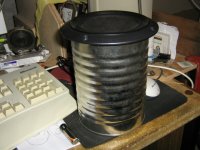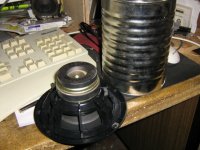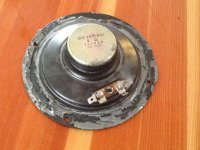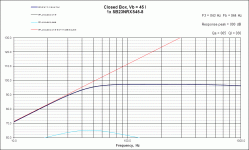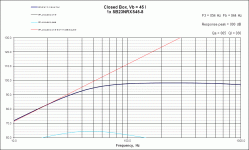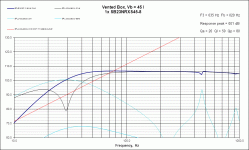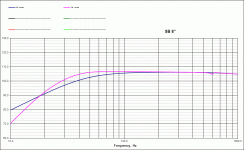HI all
As a newcomer to speaker design, I have downloaded WIN ISD Pro. It is a powerful tool and has helped me understand the physics of how speakers and drivers work.
But I have one question which I hope is not too dumb...
How do you use WIN ISD (and other programmes)to design muti-way speakers?
The programme sizes cabinets for individual drivers. Do you sum the cabinet volumes for each driver or is the definitive volume that of the largest driver as the drivers can share volume?
Thanks
Steve
Sydney, Australia
As a newcomer to speaker design, I have downloaded WIN ISD Pro. It is a powerful tool and has helped me understand the physics of how speakers and drivers work.
But I have one question which I hope is not too dumb...
How do you use WIN ISD (and other programmes)to design muti-way speakers?
The programme sizes cabinets for individual drivers. Do you sum the cabinet volumes for each driver or is the definitive volume that of the largest driver as the drivers can share volume?
Thanks
Steve
Sydney, Australia
G'day Steve, from 700km to the west of you (still in NSW though, Broken Hill's another 440km away).
I'm not at all knowledgeable about speaker building, although I did put together a 3-way last winter. In a 3-way where the woofer is ported, you have one "chamber" for that, and a separate chamber for the mid. My cabinet has a 3.6l sealed section for the 5.25" mid, while the 8" woofer more-or-less has the rest of the 68l or so, less internal bracing and the dimensions of the mid sealed section. The tweeter can "share" with the woofer as far as I know but it does depend on the type of tweeter, so it doesn't necessarily need a chamber of its own. My cab is TMW but MTW is also entirely possible (and common, I guess). I preferred to get the tweeter up to somewhere near ear height while seated as opposed to the tweet on my old Wharfedales pointing at my navel
I guess it's possible to have a ported mid as well, obviously with a second port (or even sealed for both, depends on the drivers, of course). There are considerations about where the port goes (front or back) size/length etc which are beyond my abilities, I just used what the recipe said In any case, ports are poisonously expensive for us here in Oz (I've added PE $3 ones to my cart only to have freight go up by $20!) so it's either put up with ridiculous prices from UK or US or make your own, or try to find local stuff (Jaycar, although they're not cheap either). It's even expensive to send electrons to Oz, apparently, given ITunes' prices here
In any case, ports are poisonously expensive for us here in Oz (I've added PE $3 ones to my cart only to have freight go up by $20!) so it's either put up with ridiculous prices from UK or US or make your own, or try to find local stuff (Jaycar, although they're not cheap either). It's even expensive to send electrons to Oz, apparently, given ITunes' prices here
As I understand it you model each driver in WinISD (it should tell you whether sealed or ported etc is best for your driver) and build around those dimensions. BSC and crossover stuff is over my head, no doubt much more knowledgeable people will answer your question more fully when their time zone catches up with ours
I'm not at all knowledgeable about speaker building, although I did put together a 3-way last winter. In a 3-way where the woofer is ported, you have one "chamber" for that, and a separate chamber for the mid. My cabinet has a 3.6l sealed section for the 5.25" mid, while the 8" woofer more-or-less has the rest of the 68l or so, less internal bracing and the dimensions of the mid sealed section. The tweeter can "share" with the woofer as far as I know but it does depend on the type of tweeter, so it doesn't necessarily need a chamber of its own. My cab is TMW but MTW is also entirely possible (and common, I guess). I preferred to get the tweeter up to somewhere near ear height while seated as opposed to the tweet on my old Wharfedales pointing at my navel

I guess it's possible to have a ported mid as well, obviously with a second port (or even sealed for both, depends on the drivers, of course). There are considerations about where the port goes (front or back) size/length etc which are beyond my abilities, I just used what the recipe said
As I understand it you model each driver in WinISD (it should tell you whether sealed or ported etc is best for your driver) and build around those dimensions. BSC and crossover stuff is over my head, no doubt much more knowledgeable people will answer your question more fully when their time zone catches up with ours
Last edited:
WinISD is only for modeling the cabinet loading of the driver. That's the first 5% of speaker design. Prototyping and measuring are next. That will get you to understand a single driver in a cabinet and how far off the models can be. Then on to crossovers and compensation networks.
You don't want your mid and woofer to share the cabinet. If using multiple identical woofers, yes they can share. I have never seen a reason for a ported mid. 99% of the time you would but them in a chamber that is too big so the cabinet does not load it at all. This is NOT an IB, but it works effectively the same as one. Most tweeters are already in a sealed cabinet. If not, then you have to isolate them too.
Where to start is really hard to describe. I guess I have been at it too long and when I started we didn't have PC based tools. We didn't have PC's. A program like Sound Easy has all the tools to design a speaker. It is expensive and you had better be an expert in designing a speaker before you would have a clue how to use it. Model software helps an engineer who knows what he is doing. It does not replace them.
I am not a fan of full range drivers, but that is a way to start. After understanding the box and how it relates to T/S parameters, yo then need to download the Edge ( also free) to understand baffle step and edge diffraction. Read Olson. So, with a single full range driver, you can learn all about the box and compensation networks before you get your head to explode with crossovers. I think if I were to lay out a course to teach, I would start with a full range that is ill behaved ( most are) and then beat it into submission, add a tweeter, then add a woofer. I think that could be taught in a year providing the students were already woodworkers and had a 2 year degree in electronics.
There is one and only one truth in speaker building: It depends
You don't want your mid and woofer to share the cabinet. If using multiple identical woofers, yes they can share. I have never seen a reason for a ported mid. 99% of the time you would but them in a chamber that is too big so the cabinet does not load it at all. This is NOT an IB, but it works effectively the same as one. Most tweeters are already in a sealed cabinet. If not, then you have to isolate them too.
Where to start is really hard to describe. I guess I have been at it too long and when I started we didn't have PC based tools. We didn't have PC's. A program like Sound Easy has all the tools to design a speaker. It is expensive and you had better be an expert in designing a speaker before you would have a clue how to use it. Model software helps an engineer who knows what he is doing. It does not replace them.
I am not a fan of full range drivers, but that is a way to start. After understanding the box and how it relates to T/S parameters, yo then need to download the Edge ( also free) to understand baffle step and edge diffraction. Read Olson. So, with a single full range driver, you can learn all about the box and compensation networks before you get your head to explode with crossovers. I think if I were to lay out a course to teach, I would start with a full range that is ill behaved ( most are) and then beat it into submission, add a tweeter, then add a woofer. I think that could be taught in a year providing the students were already woodworkers and had a 2 year degree in electronics.
There is one and only one truth in speaker building: It depends
Thanks guys for your replies.
What has been throwing me is that my old 3 -way speakers have drivers sharing the same box, ie no separate compartments. But they sound ok to me....
Therefore I am interested in trying to at least optimise their performance to some extent.
I certainly do not presume to be an instant expert. I see that this could be a pursuit or passion that could take up a lot of my time, but I'm not sure if I want it to.
Kits may be the way to go....
MikeCobar: i have used PVC pipe for ports -orange conduit or small diameter PVC pressure pipe.A lot cheaper.
Cheers
What has been throwing me is that my old 3 -way speakers have drivers sharing the same box, ie no separate compartments. But they sound ok to me....
Therefore I am interested in trying to at least optimise their performance to some extent.
I certainly do not presume to be an instant expert. I see that this could be a pursuit or passion that could take up a lot of my time, but I'm not sure if I want it to.
Kits may be the way to go....
MikeCobar: i have used PVC pipe for ports -orange conduit or small diameter PVC pressure pipe.A lot cheaper.
Cheers
Thanks guys for your replies.
What has been throwing me is that my old 3 -way speakers have drivers sharing the same box, ie no separate compartments. But they sound ok to me....
They aren't closed back mid's are they? I've had a few closed back ones in my old three ways over the years.
Certainly if they are normal drivers then they will tend to act as a passive radiator for the main bass drivers, which will change the tuning of the box, and also muddy up the midrange because the mid driver is getting interfered with by the bass. Have you got a picture of the mid drivers back?
Tony.
MikeCobar: i have used PVC pipe for ports -orange conduit or small diameter PVC pressure pipe.A lot cheaper.
Cheers
Yeah, I've done the same, my first build with single Aura 3" just had 1" water pipe from local hardware store.
Wintermute:
Not sure what you mean by 'closed back mids'? They are a simple one chambered sealed box containing the three drivers (sealed until I cut a port opening in front).
Your explanation of possible interference makes perfect sense and is probably exactly what is happening. Sad part is that I have more than likely been listening to inaccurate sound for 30 years which makes me more determined to put it right.
Purchased 30 yrs ago from a now defunct music shop near cinemas on George St, Sydney...
Not sure what you mean by 'closed back mids'? They are a simple one chambered sealed box containing the three drivers (sealed until I cut a port opening in front).
Your explanation of possible interference makes perfect sense and is probably exactly what is happening. Sad part is that I have more than likely been listening to inaccurate sound for 30 years which makes me more determined to put it right.
Purchased 30 yrs ago from a now defunct music shop near cinemas on George St, Sydney...
Something like this Massive Audio M8C - Close-Back Mid-Range Massive Audio Basically it has a completely enclosed back on it so that it doesn't need a separate enclosure. I had two types. Cheap polycone's with a steel sealed back (which were pretty awful) and some Phillips dome mids which had quite a decent sized chamber on the back.
It wasn't DME Hi-Fi was it? That is the only HI-FI shop that I can remember that was near the cinemas.... I think I bought a tape deck for my parents there
I lived with my (most certainly less than optimal) three ways for about 26 years before finishing my current speakers, and for a lot of that I thought that they were fantastic! It wasn't until I heard something really outstanding that I realised that they were far from great, it was just that I had never heard anything better (than them) before that!
Tony.
It wasn't DME Hi-Fi was it? That is the only HI-FI shop that I can remember that was near the cinemas.... I think I bought a tape deck for my parents there
I lived with my (most certainly less than optimal) three ways for about 26 years before finishing my current speakers, and for a lot of that I thought that they were fantastic! It wasn't until I heard something really outstanding that I realised that they were far from great, it was just that I had never heard anything better (than them) before that!
Tony.
In winisd pro you can also simulate the filter and see the group-delay change.
So when people say you can only model bass isn't true.
Yes, you can add filters, but this is nothing like the CAD programs for crossover design because this is predicting perfect acoustic response and perfect impedance. A real crossover design program works of the real measured acoustic response. Useless for crossover design IMHO. My standard tool for driver selection and box suitability.
I take it the boxes are either sealed, or vented, I know some much older speakers used to have perforated backs on the boxes so they effectively were open back. If that were the case there would be less of a problem not having the mids in the same enclosure.
Something like this (depending on what volume the mid needs) can be an easy option (note I haven't ever used one of these so don't know how well they work in practice). Midrange Enclosure 0.8 litre
My 5" drivers need a volume of about 5L so it is very driver specific.
Tony.
Something like this (depending on what volume the mid needs) can be an easy option (note I haven't ever used one of these so don't know how well they work in practice). Midrange Enclosure 0.8 litre
My 5" drivers need a volume of about 5L so it is very driver specific.
Tony.
Most mids will get crossed over so far above their resonance, they become very tolerant of the enclosure. Where the mids I am looking at might model at 3 L to give me 110 Hz, I am going to cross over at 500, so they need something just big enough to clear them, stuffed well of course. I like really solid isolation, like 80mm MDF. The old Ditton 44 had a nifty trick. It used a heavy cardboard tube glued front to back, so it was both the mid chamber and the primary cabinet brace.
Most tweets are sealed, but the SB29 tweeter has a flimsy plastic back chamber that seems to actually be part of the damping. So if I were to use one of these, I would put it in a chamber. I won't as the CSD plots tell me these things just don't know when to stop flopping the breeze.
Most tweets are sealed, but the SB29 tweeter has a flimsy plastic back chamber that seems to actually be part of the damping. So if I were to use one of these, I would put it in a chamber. I won't as the CSD plots tell me these things just don't know when to stop flopping the breeze.
And some midrangers are very tolerant of box size and shape and can be used with too big boxes if the crossovers takes most off the bass away
Cheap Sony woofer fits a Milo tin perfectly
Cheap Sony woofer fits a Milo tin perfectly
Attachments
Last edited:
Thanks yr replies.
I may have been a bit hasty in declaring the mid driver as 'normal'. In looking more closely at it and links provided by Tony, the mid driver appears to have a metal sealed back... See photo attached.
This may explain design of speaker.
Either way, way to go now appears to be to construct separate compartment for new Peerless mid 4in (5.0 l according to WIN Isd) and find an 8 in driver best suited for a small cabinet approx 45 litres.
Of course this ignores existing cross overs and whether they are any good for new drivers, but one step at a time!
Anyone recommend any suitable 8 in woofers? I see Peerless and Scan speak do woofers with low Fs anywhere from $250 -$350 AUD; for that I might be better off with new speakers!
I may have been a bit hasty in declaring the mid driver as 'normal'. In looking more closely at it and links provided by Tony, the mid driver appears to have a metal sealed back... See photo attached.
This may explain design of speaker.
Either way, way to go now appears to be to construct separate compartment for new Peerless mid 4in (5.0 l according to WIN Isd) and find an 8 in driver best suited for a small cabinet approx 45 litres.
Of course this ignores existing cross overs and whether they are any good for new drivers, but one step at a time!
Anyone recommend any suitable 8 in woofers? I see Peerless and Scan speak do woofers with low Fs anywhere from $250 -$350 AUD; for that I might be better off with new speakers!
Attachments
You could do a lot worse than these http://www.wescomponents.com/datasheets/Speakers/SB_Acoustics/SB23NRXS45-8.pdf
I've been working with some 4" SB drivers and I'm very impressed with them!
The 8" linked above models very well in 45L sealed enclosure (with heavy fill). F3 around 43Hz F10 around 25Hz.
linear travel runs out at about 10W but I think it should be fine up to probably as much as 50W.
Note sure of the retail price of them but suspect that they would be somewhere around the $100 mark each.
Wagner are in Ashfield.
Tony.
I've been working with some 4" SB drivers and I'm very impressed with them!
The 8" linked above models very well in 45L sealed enclosure (with heavy fill). F3 around 43Hz F10 around 25Hz.
linear travel runs out at about 10W but I think it should be fine up to probably as much as 50W.
Note sure of the retail price of them but suspect that they would be somewhere around the $100 mark each.
Wagner are in Ashfield.
Tony.
Attachments
Scrap the above. I thought that the modeling seemed very good for a 8"! My unibox still had 2 ohms of series resistance from when I was playing around on a previous incarnation.... After changing to 0.2 ohms it's not quite so fantastic but still respectable. However recommended box size is only 35L.
vented at 45L with this driver might be an option too.
Tony.
vented at 45L with this driver might be an option too.
Tony.
Attachments
Last edited:
- Status
- This old topic is closed. If you want to reopen this topic, contact a moderator using the "Report Post" button.
- Home
- Loudspeakers
- Multi-Way
- WIN ISD Pro and multiway design
